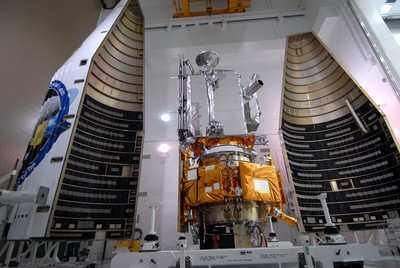NASA's LRO Team Helps Track Laser Signals To Russian Rover
Mirror
 Using information provided by NASA's Lunar Reconnaissance
Orbiter (LRO) instrument teams, researchers at the University of
California San Diego have successfully pinpointed the location of a
long lost light reflector left on the lunar surface by bouncing
laser signals from Earth to the Russian Lunokhod 1
retroreflector.
Using information provided by NASA's Lunar Reconnaissance
Orbiter (LRO) instrument teams, researchers at the University of
California San Diego have successfully pinpointed the location of a
long lost light reflector left on the lunar surface by bouncing
laser signals from Earth to the Russian Lunokhod 1
retroreflector.
The initial imaging of the two Russian rovers, Lunokhod 1 and 2
were made earlier this year by the Lunar Reconnaissance Orbiter
Camera (LROC) team, led by Mark Robinson from Arizona State
University in Tempe. On April 22, Tom Murphy from the University of
California San Diego and his team sent pulses of laser light from
the 3.5 meter telescope at the Apache Point Observatory in New
Mexico, zeroing in on the target coordinates provided by the LROC
images and altitudes provided by the Lunar Orbiter Laser
Altimeter." We quickly verified the signal to be real and found it
to be surprisingly bright: at least five times brighter than the
other Soviet reflector, on the Lunokhod 2 rover, to which we
routinely send laser pulses," said Tom Murphy, an associate
professor of physics at the University of California San Diego.
"The best signal we've seen from Lunokhod 2 in several years of
effort is 750 return photons, but we got about 2,000 photons from
Lunokhod 1 on our first try. It's got a lot to say after almost 40
years of silence."
 Since Apollo deployed laser retroreflectors, astronomers have
routinely used them to track how the moon is slowly moving away
from the Earth. This helps scientists develop a better
understanding of the processes that are causing this motion,
including what's occurring inside the moon's core and the tidal
motions on the Earth.
Since Apollo deployed laser retroreflectors, astronomers have
routinely used them to track how the moon is slowly moving away
from the Earth. This helps scientists develop a better
understanding of the processes that are causing this motion,
including what's occurring inside the moon's core and the tidal
motions on the Earth.
The Lunokhod 1 retroreflector was sent aboard the unmanned Luna
17 mission, which landed on the moon November 17, 1970, releasing a
robotic rover that roamed the lunar surface. Murphy said his team
had occasionally looked for the Lunokhod 1 retroreflector over the
last two years, but had little chance of finding it until the LRO
team produced coordinates based on the recent images of the lander
and rover that were good to within 100 meters. "It turns out that
our previous best-guess position was miles off," he said. "We could
only search one football-field-sized region at a time, so without
LRO, we never would have found it. But with the new coordinates, we
found the signal promptly at the very edge of our available
window."
Locating Lunokhod 1 and measuring its exact coordinates is
important in furthering our understanding of the moon."Getting more
than a few photons back from an unknown location at the distance of
the moon is quite an achievement. The rediscovery of the Lunokhod-1
retroreflector was made possible by the LRO camera team and by the
diligence of Tom Murphy," said Gregory Neumann, Lunar Orbiter Laser
Altimeter team member from NASA Goddard Space Flight Center in
Greenbelt, MD. "That we have located it so quickly and ranged to
the Lunokhod rover, last heard from September 14, 1971, is a
tribute to Tom's team and to the amazing LRO observatory and
instrument teams."
LRO is scheduled for a one year exploration mission in a polar
orbit about 31 miles above the lunar surface. During this time, LRO
will acquire information for a new comprehensive map of the lunar
surface in unprecedented detail, search for resources and potential
safe landing sites for a potential future return to the moon and
measure lunar temperatures and radiation levels. LRO will move into
its science phase in September, when the program management
responsibility moves from the Exploration Systems Mission
Directorate to the Science Mission Directorate at NASA
Headquarters. LRO will continue to map the moon for two additional
years during its science phase with the possibility of two more
years of observation following that.

NASA LRO LCROSS Spacecraft
NASA's Goddard Space Flight Center built and manages the mission
for the Exploration Systems Mission Directorate at NASA
Headquarters in Washington. The Institute for Space Research,
Moscow, provides the neutron detector aboard the spacecraft.More
information can be found about LRO at:
 ANN's Daily Aero-Term (04.25.24): Airport Rotating Beacon
ANN's Daily Aero-Term (04.25.24): Airport Rotating Beacon ANN's Daily Aero-Linx (04.25.24)
ANN's Daily Aero-Linx (04.25.24) Klyde Morris (04.22.24)
Klyde Morris (04.22.24) Airborne 04.24.24: INTEGRAL E, Elixir USA, M700 RVSM
Airborne 04.24.24: INTEGRAL E, Elixir USA, M700 RVSM Airborne 04.22.24: Rotor X Worsens, Airport Fees 4 FNB?, USMC Drone Pilot
Airborne 04.22.24: Rotor X Worsens, Airport Fees 4 FNB?, USMC Drone Pilot





